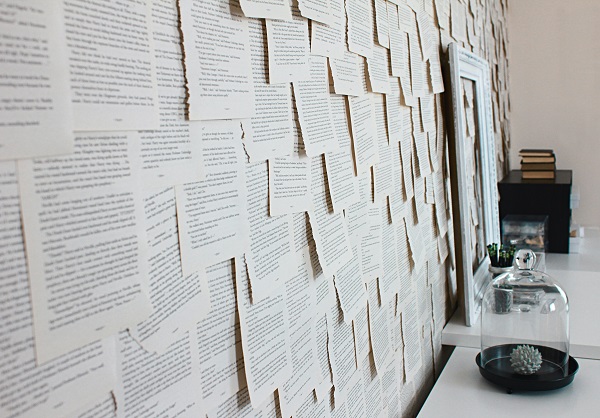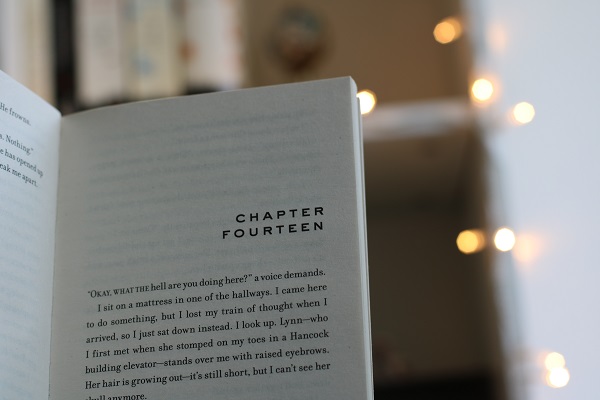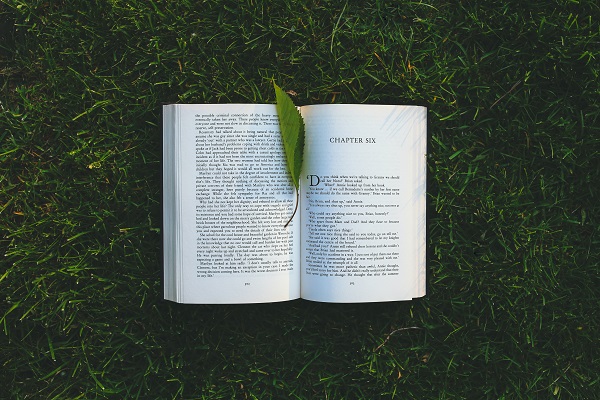The first piece of advice I received on this topic was from my Screenwriting 101 teacher.
He taught that scenes are camera cuts where the setting or time changes, and chapters are like sections of a TV episode that end with ad breaks.
In book terms, a scene is an important point in your story where a character tries to accomplish a goal but faces obstacles. A chapter is a pause in a novel, usually demarcated by a page break and new heading.
Scenes are essential to the plot, whereas chapters just help to break up the narrative and control the pace.
Most writers ask about scenes versus chapters because they’re trying to structure a novel, and wondering, for instance, just how many scenes should be in a chapter, or where exactly to end a chapter.
Whether you’re a plotter (structured drafter), a pantser (free spirit), or somewhere in the middle, having a strong grasp of the differences between scenes and chapters can help you organise your writing so that it’s well-paced and coherent, and keeps your reader engaged.
What is a scene?
Think of a scene as a memorable and significant moment in your story, during which the protagonist sets out to achieve something and is met with conflict, which often leads to disastrous outcomes.
This is the ‘action’ of your novel.
There’s also a sneaky second part to a scene, which many writers and theorists refer to as the ‘sequel’.
The sequel is where the protagonist emotionally reacts to what has happened, puzzles through the dilemma, and decides on a new course of action.
This leads readers into the next scene in a neat little game of dominoes, building up the suspense and a sequence of action, reaction, action, reaction events, until the final piece of the novel inevitably falls into place.
Sounds easy, right? *cue nervous laughter*
Yeah, it’s not that easy. Writing never is.
To help you avoid writing hundreds of thousands of words that just end up as backstory or character development, let’s break it down a little further.
Structural elements of a scene
Scenes are the building blocks of your story. A scene usually takes place in one time and place.
There’s often a relationship between how long it takes for something to happen, and how long it takes for the narrator to recount those happenings.
You don’t want to spend equal time describing your character brushing their teeth in the morning, and diffusing a bomb later that day.
If your novel follows your protagonist’s life in real time, with no compressed action or summary, it’s going to get monotonous pretty quickly! This is why scenes need to be significant.
In Making Shapely Fiction, writing teacher Jerome Stern gives the example of a child having a tantrum as the perfect metaphor for making a scene.
When you want your character to get the most attention from your reader, for a really important reason, make a scene for them!

Below, I’ve outlined the four elements of a scene that will help you to engineer a structurally sound story: Goal, Conflict, Disaster and Sequel.
1. Goal
Your novel needs an overarching story question: something your protagonist (and reader!) has a deep, burning desire to have answered.
- Will Frodo deliver the One Ring to Mordor?
- Will Elizabeth find a husband who’s right for her?
- Will Harry defeat Voldemort?
- Will Little Red Riding Hood overthrow the patriarchy?
Scenes are stepping stones to the protagonist’s overall story goal, so they need their own mini-goals, giving readers something more short-term to worry about:
- Will Frodo survive the attack of the Dark Riders?
- Will Elizabeth find a dance partner at the ball?
- Will Harry even make it to Hogwarts this year with that pesky house elf always trying to thwart him?
- Will Little Red shake off the creepy wolf in the woods?
Often the answer to these questions is a simple yes or no. Except that it isn’t quite that simple…
2. Conflict
Protagonists have it rough; it’s never easy for them to achieve even their mini-goals.
They need to struggle against another character or obstacle. They need to battle to get the kids ready for school on time, or manoeuvre the plane through hostile enemy airspace.
They need to misunderstand their best friend, put salt instead of sugar in the bake sale cake, lose their bus pass, argue with the bank teller, crash their car.
They need to try different tactics and work around problems.
As with the examples above, conflict can be physical or verbal, but it must involve some kind of action.
Passive characters are the enemies of conflict. There’s a reason ‘and they all lived happily ever after’ is never found in the middle of a book.
The conflict in a scene is also usually played out moment by moment, with no summary.
If your protagonist approaches their boss for a raise and an argument ensues, we’re right there in the room with the pair of them.
We hear them yelling at each other, see the speckles of spit flying from the manager’s mouth, and feel the building frustration.
The more you flesh out the reality of this situation for the reader, the more you will heighten the tension in each of your scenes.
If external conflict heightens the protagonist’s internal conflict, that’s even better.
The fight with the boss might also make the protagonist’s internal demons creep up again, as they tell themselves they’re not good enough after all, and that they should just quit.
Whatever your conflict, make sure your protagonist remains as active as possible.

3. Disaster
Suspense is built through setbacks, not good news. By the end of your scene, there should be an answer to your protagonist’s mini-goal: did they achieve it or not?
Except… Remember when I said it wasn’t that simple?
There are actually four paths to take here:
- Yes! (Hooray! All done!)
- No! (Uh-oh. Let’s try something else.)
- Yes, but… (Uh-oh. Now there’s an even bigger problem)
- No, and what’s worse… (Disastrous! What have I gotten myself into now?)
It’s pretty clear that a straight up ‘Yes!’ isn’t going to be much good for tension or suspense. If your scene doesn’t end in any form of ‘disaster’, then your reader has a chance to disengage emotionally.
In saying that, the ‘disaster’ doesn’t have to be a literal disaster – and it should grow organically out of the conflict.
The solution to a fight between mother and daughter can’t just be that there’s a sudden and unexpected tsunami (unless this makes sense in the wider themes of your novel, and leaves the conflict unresolved).
‘No!’ isn’t the strongest resolution for a scene, either, as it means that essentially the story hasn’t progressed in any way.
While some conflict or action might have excited the reader for a moment, the ‘no’ option sometimes means the scene could easily be removed with no bearing on the rest of the novel.
‘Yes, but…’ creates more tension, suspense and sympathy for the character, because although they’ve achieved their short-term goal, now there’s another obstacle between them and the final outcome.
‘No, and what’s worse…’ can be catastrophic for the character. Not only did they not achieve their goal, but they’re further than ever from their overarching story goal, and perhaps in much worse shape.
You’ll often find scenes like these just before the climax of a novel, bringing the tension and stakes to an absolute pinnacle.
In deciding how disastrous a scene will be, consider the overall pace of your novel, the intended audience, and the rollercoaster of emotions that you’ve taken your reader on.
Remember, the more difficult this is for your protagonist, the more emotional payoff for the reader at the end of the novel.
4. Sequel
Sequels come after scenes, but are closely related, which is why I’ve included them in the four structural elements of a scene.
Some theorists prefer to think of sequels as part of the ‘sequence’ of a narrative setup, scene and reaction. That’s okay, too!
The important thing is that you include mini-goals, action and reaction as you build your story.
Sequels involve the protagonist’s emotional reaction to the ‘disaster’. A scene is all about the excitement, and a sequel is all about processing it, for both the character and the reader.
You could have a whole chapter that is essentially the sequel to a scene, or just a few lines.
A sequel should begin with raw emotion and not much thinking. Then, at some point, the protagonist can begin to process what happened, why, and what it all means.
When they finally decide what to do next, they put their plan into action. Voila! That’s the beginning of your next scene!

Here’s an example of a short but intricate sequel from Oscar Wilde’s The Picture of Dorian Gray:
“Three o’clock struck, and four, and the half-hour rang its double chime, but Dorian Gray did not stir. He was trying to gather up the scarlet threads of life, and to weave them into a pattern; to find his way through the sanguine labyrinth of passion through which he was wandering. He did not know what to do, or what to think. Finally, he went over to the table, and wrote a passionate letter to the girl he had loved…”
It’s important to keep in mind that a sequel often differs from the action in a scene because it’s rarely moment by moment, or blow by blow.
You can treat the passage of time differently in a sequel. Rather than using ‘real-time’, you can:
- Summarise: e.g. Billie fell into a state of depression, wading around in the darkness for weeks on end.
- Transition into backstory or memory related to the drama or emotion of the scene/event that’s just occurred.
- Flash forward to a future point in time that is a direct or indirect consequence of the previous scene.
Narrative elements of a scene
Now that you have an idea of the structural elements of a scene, you might be wondering what’s actually in the scene. You have the building blocks – but what do they look like?
This is where you’ll need to consider some key elements of narrative, including characters, setting and plot.
Characters
Every scene needs at least one character, even if it isn’t always your main protagonist.
If there’s another character whose point of view is integral to the novel, they might be the main character in a scene. It could be an animal, or a robot, or an old weathered house that acts as the main perspective.
Just make sure that whoever or whatever they are, they have a goal or purpose, and the inclusion of their scene is relevant to the overall story goal.
Narrative elements related to character that you can include to make your scene come alive include direct dialogue, physical reactions and gestures, and internal monologue (i.e. what your characters are thinking).
Setting
Your scene will need to take place in one location, or two locations that aren’t completely unrelated (e.g. at the bus stop and on the bus).
When there’s a major change in location, it likely means you’re starting a new scene. The exception would be the sequel – this might take place in a different setting to the main action in the scene.
For example, after a character is involved in a car accident (scene), they might wake up from a nightmare the next morning, reflecting on what happened (sequel).
Make sure to include all five senses when describing your setting. What do we see, hear, and smell? What does the space feel like? Is there a taste in the air?

Plot
It’s evident from the structural elements of your scene that there needs to be a strong plotline in each scene, usually with some kind of beginning, middle and end.
You should also carefully consider the timing and pace of each scene.
Try to include a great opening line or hook, as well as goals, conflict, ‘disaster’ and emotional resolution.
Screenwriter Robert McKee also suggests that there should be a polarity shift in a scene: things need to go from good to bad, or bad to good.
Otherwise, it’s likely there was no kind of conflict, which means nothing really happened, which means your reader will get bored.
If you find the direction of the story changing, or if you’re delving into a related and meaningful subplot, consider starting a new scene.
How and when to start/end a scene
Scenes change through three main methods:
- Switching location/setting
- Time passing
- Changing point of view (POV)
Characters entering or exiting the scene are a commonplace to start a new scene or end a scene, but keep in mind that this isn’t always necessary.
You don’t want a scene to always begin with a character waking up/starting their day, or entering a space.
Sometimes, it’s good to drop the reader right in the middle of the action or a conversation, because remember: scenes are memorable moments in your protagonist’s journey towards their story goal. Not the boring bits!
How long should a scene be?
There’s no hard and fast rule for this.
An action or thriller novel will often have shorter scenes to create a faster pace, whereas a romance or literary novel might have longer scenes to give characters time to muse over their feelings and readers time to sit with narrative threads and themes.
Key scenes like the inciting incident, climax or turning points might have longer scenes. These are usually packed with more action, and this will keep readers engaged.
If you feel the word count of your scene is too long, consider whether you’ve actually got multiple mini-stories within your scene:
- Can it be broken into two, with a time gap in the middle?
- Do you need to trim excess characters from the scene?
- Have you spent too long describing a particular location that isn’t important?
- Is there some dialogue that can be trimmed because it’s not moving the plot forward?
If you’ve followed the structural elements of the scene, with clear scene goals, conflict and consequences, your scenes should naturally act as mini-stories, which drive the plot forward and maintain the pacing of your novel.
This means that no matter what the length, they’re important to your story.
Signalling scene breaks
When you’re ending a scene, you’ll create what’s called a ‘scene break’ to visually signal to the reader that something is changing; usually the location, time or point of view.
You can create a scene break by:
- Leaving a space between paragraphs (sometimes known as a soft scene break)
- Separating paragraphs with a centred asterisks or another symbol/ornament (sometimes known as a hard scene break or, hilariously, a dinkus)
Different editors and publishers will have their own rules and guidelines about how they do this, so it’s just important that you’re consistent.

What is a chapter?
Chapters are more arbitrary pause points in your novel, predominantly meant to control pace.
They aren’t as complex or vital as scenes, but sometimes they, too, can act as mini-stories within your novel.
It’s important to understand how chapters work so you can make informed decisions about how to use them, or whether to use them at all.
Each chapter, like each scene, is building on the conflict, tension or plot development in the previous chapter. The purpose of a chapter is to:
- Control the pace of your novel
- Keep readers engaged in the story
- Give readers breathing space between key moments so they’re not overloaded with information
- Create suspense and interest
Examples of creative use of chapters
- In books with multiple POV characters, each chapter is generally written from a different character’s perspective, so we know when we’re ending one chapter that we’re about to hear from another character.
- Stephenie Meyer’s Twilight series famously used chapter headings with no accompanying text to represent months passing while Bella, the protagonist, fell into a deep depression over her one true sparkly vampire love.
- Kate Jennings’ novella Snake breaks down into four parts, each of which includes mini-chapters, like short vignettes, mirroring the bare-bones prose as the failure of an unhappy marriage is exposed.
- Sven Lindqvist’s A History of Bombing is written in chronological chapters, but they are made to be read out of order, by following one of the many paths or ‘ways into the book’, which are organised by stories that jump backward and forward through time.
- Stephen King’s Misery has famously short chapters (one is just a single word: ‘Rinse.’), which are snippets from scenes, and ominous as anything.
- Ray Bradbury’s Something Wicked This Way Comes also contains a short chapter of one sentence, representing time passing: ‘Nothing much else happened that night.’
- William Faulkner’s As I Lay Dying famously has a chapter that simply states, ‘My mother is a fish.’ This is an example of a single thought (i.e. only a small fragment of a scene) making up an entire chapter.
- James Patterson’s action novels often have chapters that are just one scene long, and often go for less than a page.
- J.K. Rowling’s Harry Potter series has longer and more immersive chapters, which draw readers into the fantasy world of Hogwarts.
- Charles Dickens’ A Tale of Two Cities has 45 long chapters, as it was originally published in 31 instalments in a literary periodical.
- Marilynne Robinson’s Gilead has no chapters at all, with long, slow-paced descriptions inviting the reader to understand the thoughts of an ageing, dying man.
- Jane Austen’s Persuasion has chapters that get longer and longer, building to a crescendo along with the story.
- Eleanor Catton’s The Luminaries, on the other hand, has chapters that decrease in word count to mirror the waning moon.

How and when to start/end a chapter
If you’re anything like me, you’ll be determined to get to the end of a chapter before putting a book down. But our job as novelists is to convince readers that they should just keep reading!
Begin and end chapters in a way that will hook readers back into the story experience. This might mean starting or ending a chapter in a similar way to starting or ending a scene.
However, this doesn’t necessarily mean that every time a scene ends, you need to begin a new chapter. For example:
- Chapters can contain multiple scenes, which are ordinarily related.
- Chapters can contain only one scene, or even just a portion of a scene, if it’s a really important one that you think should span multiple chapters.
- Chapters can stop midway through a scene to enhance suspense.
- Chapters can skip a few scenes and pick up in the future to make the reader more active.
If the protagonist’s goal or thinking changes drastically, they have some kind of revelation, or the direction of the story begins to change, you can also consider a new chapter.
Some common ways to end a chapter include:
- Cliffhangers. This doesn’t necessarily need to be (but totally could be!) a character hanging off a cliff – just something equally as suspenseful.
- Arrivals. A new character arrives at the scene, who is bound to change the direction of the story.
- Questions. This could be a literal question, or just a thought-provoking moment that makes the reader curious.
Like a scene, you can also begin a chapter with a shift in time, location or point of view, or right in the middle of the action.
The important thing is that your chapter structure enhances your story and moves the novel forward, maintaining that always-vital reader engagement.
Remember, this won’t happen if you haven’t first analysed your scenes, so start with scenes, and think about chapters later.
How long should a chapter be?
Again, there’s no hard and fast rule. Voice, story, structure, genre and style can all play a part in deciding how long each chapter should be.
I’d recommend waiting until you’ve written at least a second draft before you make decisions on where you want your chapter breaks to go.
This way, you know that you’ve already neatened up overly long scenes, or excluded extraneous bits of writing, before agonising over where to break up your chapters.
If your scenes aren’t in good shape yet, there’s no point worrying about chapters.
Conversely, if you’re breaking up your chapters and getting stuck, it might be an indicator of a weak scene or transition. Can you try re-ordering your scenes, or taking sections out?
Creating a time gap between chapters (even if it’s only a few minutes, rather than days or weeks later in the story) is one way to breathe fresh air into your scenes, and make for interesting and engaging chapter endings and beginnings.
Often, particularly for fledgling novelists, editors advise that chapters should be of a similar length, or at least follow some kind of clear pattern.
As you become more confident, purposefully varying chapter length here and there can help to increase tension and suspense.
There’s a great graph of some well-known novels that looks at their average chapter length, suggesting that the average word count of chapters can range from 1,500–5,000 words, but greatly depends on the type of novel.
Others say that the length of a chapter should be under 2,000 words, which means it will likely take the (adult-level) reader ten minutes or less, in this modern age of short attention spans.

When you’re ready to break your work into chapters, Scrivener is a great writing tool. It allows you to separate out each scene, then group your scenes into chapters, with clear word count tallies.
If you have some chapters that are very long, or very short, that’s okay. Just make sure it’s for a good reason. Is it a pivotal chapter, or do you need to trim some backstory or remove a scene that doesn’t drive the story forward?
Shorter chapters are also usually favoured by younger readers or more action-orientated genres, and longer chapters are sometimes favoured by more introspective, literary works, or romance novels.
It really does depend on your audience and the genre in which you’re writing. Read widely in your genre to familiarise yourself with the most common chapter format, as well as creative alternatives.
Signalling chapter breaks
When you’re ending a chapter, remember to think of it as a pause point or some breathing space for a reader.
The break ultimately leads them to stay engaged with your story, either through maintaining a quick pace, or slowing the pace down. Both have value.
When creating a new chapter:
- There’s generally going to be blank space on the page at the end of the previous chapter.
- There might be an entire page break. This often happens when stylistically all chapters begin on the right-hand (recto) page (i.e. the odd page number), which sometimes means leaving an entire blank page on the left side (verso).
- The simplest way is to use chronological chapter numbers. You can style this however you wish: ‘Chapter One’, Chapter 1′, ‘One’, ‘1’, etc.
- You can also title each chapter, in a way that relates to the themes of the chapter or the passing of time (the names of seasons, for instance).
- You can use a symbol or even an image.
- The first letter (drop cap) or line might be decorative and/or have larger font.
Your choice of chapter break might also depend on how much digestion time a reader needs. If you’re writing a novella, you might not need to leave much space between chapters, as the whole book is easily digestible.
Similarly, if you’re writing fast-paced action, you might quickly signal a new chapter with a bold font number on the top of the next page, and move on.
Like with scene breaks, these are all stylistic choices and ultimately publishing decisions, rather than something you need to obsess over when organising your chapters.
When you’re just beginning, pick one clear way to demarcate the beginning and end of each chapter, and be consistent.

Are these rules? And aren’t rules made to be broken?
Yes and no. I mean, technically, no and yes.
Writing a novel is a huge task, particularly if you’ve never done it before. So if there’s anything you take away from this, it will be that understanding scenes, even more so than chapters, allows you to create a structural outline for your novel.
This will make it more likely that your reader stays engaged throughout the entire story.
Writing in scenes and adding chapters later can make for a tighter, better structured first draft, as scenes have clear goals, whereas chapters are to control the reader’s experience.
By focussing on your scenes, you are more likely to build a novel where each moment advances the story and the plot. From there, creating engaging chapters becomes a lot easier!
Some writers advise not to think about chapters until the end of your first or even second draft.
If you don’t worry about scenes until the end of your novel, however, you might end up with a story that’s not really that much of a story at all.
There should be a cause-and-effect nature to your scenes, but also your chapters. One shouldn’t be able to happen until the rest have happened.
Another way to look at it is that each scene and chapter should be fundamental to your protagonist’s quest to attain the overall story goal.
Ultimately, the difference between scenes and chapters is that scenes are integral to the development of your plot, and chapters help you control pacing.
While it’s okay to break these rules-that-aren’t-really-rules as much as you like, make sure that you’re always asking yourself:
- Is each of my scenes/chapters significant?
- Do they contribute to the overall story goal?
- Do they encourage people to keep reading?
If the answer is yes, you’re on the right track.